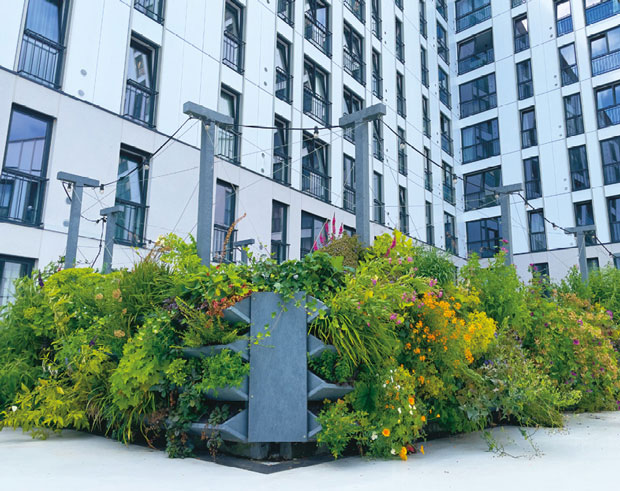 Sunil Shah, MD of Acclaro Advisory and the Sustainable Facilities Management Index (SFMI) explains why the SFMI Sustainability Benchmark has elevated wellbeing, biodiversity, and ED&I to help drive transformative change
Sunil Shah, MD of Acclaro Advisory and the Sustainable Facilities Management Index (SFMI) explains why the SFMI Sustainability Benchmark has elevated wellbeing, biodiversity, and ED&I to help drive transformative change
Sustainability is now undoubtedly a critical component of any organisational success, with stakeholder, investor, client and colleague demand for transparency high on the agenda.
Taking into account post-pandemic learnings, evolving regulations and practical examples from FM assessments, the Sustainable Facilities Management Index (SFMI)(i) has updated its 23 environmental, social and governance (ESG) assessment criteria, with a focus on wellbeing, biodiversity, and carbon-related initiatives.
COMMITMENT TO ESG AND SOCIAL IMPACT
To score highly on the assessments, FMs will now need to demonstrate their impact on colleagues and the wider community. For example, diversity is now considered a strategic issue, and internal reporting should include diversity within supply chains to display industry leadership.
Mental wellbeing has been recognised as a crucial aspect of Health and Safety and FMs should integrate it into their engagement and delivery with customers and communities. This holistic approach highlights the “S” (social) aspect of ESG and ensures that sustainable practices are embedded at all levels.
Wellbeing is a balance of physical and mental health which can not only increase productivity and reduce absenteeism but also help retain employees. Companies are increasingly looking at good wellbeing support to check and improve their performance internally and externally. Wellbeing programmes should be two-way. For example, employees feel more valued if senior management are seen to advocate and demonstrate great wellbeing practices by driving the wellbeing and mental health agenda.
The FM is increasingly playing a part in wellbeing, not just for employees and long-term contractors, but also tenants and customers. How a workplace environment is set up has a huge impact on wellbeing. We saw how this was demonstrated starkly by the COVID pandemic, and learnings are still being applied to workspaces with changed occupancy and use, for example with the more common use of HEPA filters to purify air, and regular health checks for employees.
The FM can also signpost employees towards initiatives to improve wellbeing. This may include mental health programmes and practices and more recently, improvements for sleep and its benefits for health and safety.
Gaining and acting on tenant and employee feedback is essential. Building on research, and new technologies, FMs can measure the impact of workplace changes and demonstrate improvements. However, always consider any environmental impacts to ensure there are no trade-offs.
ENVIRONMENTAL FOCUS EXPANDS
While reducing carbon emissions has rightfully garnered significant attention, the SFMI acknowledges the importance of other environmental concerns such as biodiversity and water in its scoring requirements. Assessed FMs will have to incorporate biodiversity considerations into their net zero plans, recognising the benefits for both customers and communities.
With so much of the built environment based in urban areas, management of ecology and biodiversity is important. Indoor space can offer green opportunities such as wall gardens and plant pots for filtering and improving air quality, maximising natural light and ventilation. Even though urban areas have experienced significant development and expansion, plants and animals continue to offer important benefits and functions to the environment and human society. These benefits are referred to as “ecosystem services” –such as trees supplying shade, nature regulating the environment, cultural experience through natural and green areas and supporting services such as biodiversity maintenance.
Within the built environment, outdoor space can be used to plant new wildflowers, provide hedgehog shelters, or water areas for wildlife. This type of activity can also help with wellbeing as well by engaging with employees who get involved.
FM can ensure ecology is integrated into grounds maintenance and workplace management and are aware of and minimise the ecological impacts when altering a landscape to fit the needs of each location. This requires FMs to understand and manage the impact of external spaces, which includes connecting employees and the built environment with nature. To achieve this, FMs need to understand natural capital and the value that protecting and enhancing ecology and biodiversity will bring to contracts and workplaces.
This can be demonstrated by assessing opportunities, measuring current ecology and biodiversity, and acting on the data provided. Using the Natural Capital Protocol2(ii) provides a standard way of measuring ecological impacts and dependencies across the built environment, as well as species identification surveys, biodiversity action plans, employee surveys to spot opportunities, site walk and assessments, and occupational evaluations that include ecology. Although relatively well understood for construction, improving ecology benefits are a new area of sustainability for many sectors including FM and the built environment which are still learning how this area is best approached.
Tagged with: Acclaro Advisory biodiversity Equality Diversity And Inclusion ESG assessment criteria SFMI Sustainability Benchmark sustainability Sustainable Facilities Management Index (SFMI) wellbeing






